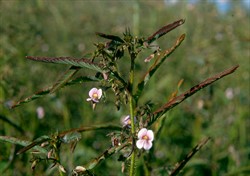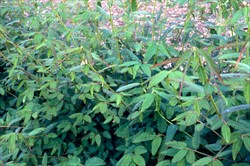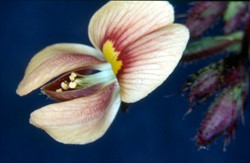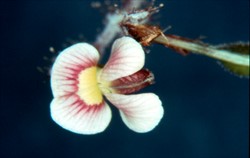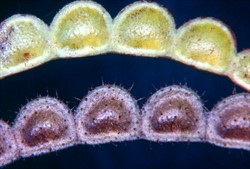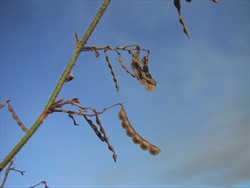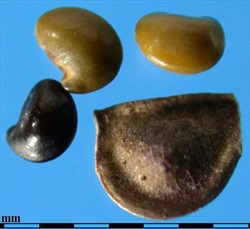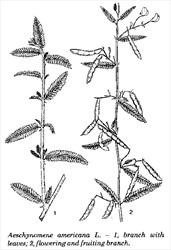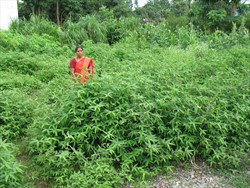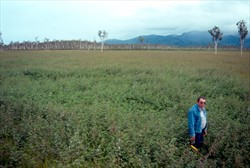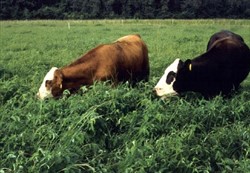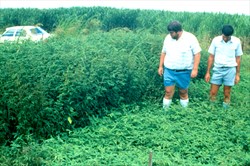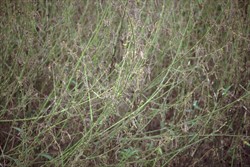Tropical Forages
Aeschynomene americana L.
Subordinate taxa:
Aeschynomene americana L. var. americana
Aeschynomene americana L. var. flabellata Rudd
Aeschynomene americana L. var. glandulosa (Poir.) Rudd
Note: The genus, Aeschynomene, is separated into two sections: Aeschynomene and Ochopodium. The former encompasses predominantly species from humid environments, such as Aeschynomene americana, Aeschynomene indica and Aeschynomene villosa, while the latter includes a number of dryland species, such as Aeschynomene brasiliana, Aeschynomene falcata and Aeschynomene histrix.
Family: Fabaceae (alt. Leguminosae) subfamily: Faboideae tribe: Dalbergieae.
An erect or ascending, rarely almost prostrate, annual or short-lived (2‒4 years) perennial subshrub, 0.5‒2 m tall and 1‒2.5 m across, depending on ecotype. Stems 1.5‒2 mm diameter in upper parts; to 4 mm, becoming hollow/pithy and more rigid with age, glabrous to hispid (bristles 1‒2 mm long, glandular); mature stems to >20 mm diameter, tending to woody. Leaves pinnate, 3‒8 cm long, grey green to dark green in colour, often with purplish tinge; leaflets (pinnae) 8‒38 pairs, 3‒15 mm long, 1‒3 mm wide, linear or oblong linear; exhibiting nyctinastic (night) and thigmonastic (touch responsive) movement causing pinnae to fold on the rachis; rachis and leaflet margins and midribs often ciliate. Hispid stems and leaves emit distinctive odour due to glandular secretions. Inflorescence a loose, few-flowered raceme, often branched; corolla varying in colour from pinkish to pale mauve or yellow-orange, standard petal 5‒10 mm long (‒15 mm in var. flabellata) and wide, usually with red or purple striations. Pod mostly slightly curved, 3‒9 segments (rarely 1 or 2), each 2.5‒5 mm wide and 3‒6 mm long (terminal and basal segments longer due to retained style and stipe), upper suture entire, the lower scalloped between joints; breaking into segments at maturity. Seeds ±kidney-shaped, 2‒3 mm long and 1.5‒2 mm wide, grey-green to light and dark brown or black. 150,000‒300,000 seed-in-pod/kg, or 350,000‒500,000 dehulled seeds/kg.
var. americana: stipules glabrous or nearly so; bracts cordate; flowers 6‒8 mm long; fruits glabrous or only slight tendency toward development of puberulence or glandular hairs on the surface or along the margins.
var. flabellata: stipules glabrous or nearly so; bracts flabellate, truncated or obtuse at the apex; flowers 8‒10 mm long; fruits glabrous or hispid.
var. glandulosa: stipules hispid at point of attachment; bracts cordate, acuminate at the apex; flowers 6‒8 mm long; fruits puberulent and/or beset with glandular hairs.
Similar species
Aeschynomene americana: flowers >6 mm long; leaflets more than 4–15 mm long; mature fruit-centre muricate.
Aeschynomene villosa: flowers 3‒5 mm long; leaflets less than 8 mm long; mature fruit-centre non-muricate.
Description based on Rudd (1955).
Asia: 敏感合萌 min gan he meng (China); सोल घास sol ghas, सोली soli (Hindi); நெட்டி netti (Tamil)(India); kacang meongan, asem-aseman, anjang (Indonesia); Amerika-kusa-nemu (Japan); karaparak, makahiyang-lalaki (also Aeschynomene indica), mala makahiya (Philippines); sano-don, sano-bok, โสนขน sa-no khon (Thailand); rút đất; đậu đồ sơn; điềm ma mỹ (Vietnam)
English: American jointvetch, common aeschynomene, joint-vetch, shyleaf, deervetch; thornless mimosa (Sri Lanka); bastard sensitive plant (Jamaica)
Latin America: carrapicho, corticinha, garrapicho, sensitiva mansa (Brazil); antejuela, cujicillo, dormidera, dormilona, golondrina regada, hierba rosario, huevo de rana, moriviví bobo, pega ropa, plumón, ronte, tamarindillo, yerba rosario, zarza (Spanish)
Native:
Northern America: Mexico (Campeche, Chiapas, Chihuahua, Coahuila, Durango, Guanajuato, Guerrero, Jalisco, Mexico, Michoacán, Morelos, Nayarit, Oaxaca, Puebla, Queretaro, Quintana Roo, San Luis Potosí, Sinaloa, Sonora, Tabasco, Tamaulipas, Veracruz, Yucatán, Zacatecas); USA (Alabama (s.), Florida (n.), Georgia (s.), Louisiana (s.)
Caribbean: Antigua and Barbuda, Bahamas, Barbados, British Virgin Islands (Tortola), Cayman Islands, Cuba, Dominican Republic, Grenada, Guadeloupe, Haiti, Jamaica, Martinique, Netherlands Antilles (Curaçao), Puerto Rico, St. Lucia, St. Vincent and Grenadines, Trinidad and Tobago (Tobago), US Virgin Islands (St. Croix, St. John, St. Thomas)
Central America: Belize, Costa Rica, Guatemala, Honduras, Nicaragua, Panama
South America: Argentina, Bolivia, Brazil, Colombia, Ecuador, French Guiana, Guyana, Paraguay, Peru, Venezuela
Cultivated/naturalized:
Africa: Malawi, Nigeria, Sierra Leone, Zambia, Zimbabwe
Asia-Pacific: Australia, Bismarck Archipelago, Papua New Guinea, Vanuatu
Indian Ocean: Andaman Is, Madagascar, Mauritius, Nicobar Is, Réunion, Seychelles
Asia: China, India, Indonesia, Laos, Philippines, Thailand, Vietnam
Forage
Primarily used as a semi-permanent or regenerating component of pasture, or as an N-fixing pioneer in areas to which it is less well adapted. Grazed and cut-and-carry or green chop. Value for standover (foggage) or hay is limited by the tendency for leaves to abscise on drying.
Environment
Can be used as a green manure crop in rice and other cropping systems.
Soil requirements
Found on soils ranging from gravels and sands to clays, but mostly on finer-textured soils. Soil pH at collection sites is mostly 6‒7, but ranges from as low as 4 to as high as 8. Mostly sown in moderately fertile soils with pH from 5.5 to 7.0.
Moisture
Found in low-lying, wet or moist situations, extending to slopes. Rainfall at collection sites is mostly between 1,000 and 2,500 mm/yr, but can be as low as 600‒800 mm, and >4,000 mm/yr. It is usually found in moist or wet situations. More tolerant of waterlogging and flooding than most warm season legumes, growth appearing to be favoured by periods of waterlogging. Under such conditions, nodules tend to form at the base of the stem. Fairly intolerant of drought. Cultivars are mostly planted in areas receiving at least 1,000 mm rain/yr.
Temperature
Occurs from about 30º N in Louisiana, USA to about 26º S in Formosa, Argentina; and from near sea level to >2,000 m asl in the tropics, but rarely at altitude in the subtropics. This equates to a range in average annual temperatures of 20‒27 ºC. Early season growth from seedlings or perennating plants is relatively slow, the bulk of growth produced in the hot, wet months. Has slight frost tolerance, but tops and often perennating plants are killed by heavier frosts.
Light
While Aeschynomene americana grows best in full sun, it can still produce 50‒60% of maximum yields at 50% light.
Reproductive development
Appears to be a short day species in relation to flowering response, the critical photoperiod varying with ecotype. Varieties native to, or naturalized in, areas with a growing season limited by temperature or rainfall tend to be early flowering, whereas those from regions with a long growing season are somewhat later flowering, e.g. accessions naturalized in Louisiana and Florida flower in January/February in southern hemisphere subtropics, and accessions from Central America may not flower until April or later in the same environment.
Defoliation
In existing stands, the area should be grazed heavily during the cold or dry season after seed set is complete, to create space for the following season's seedlings to develop. Initial seedling growth is slow. Plants may take up to 10 weeks to reach a height of 60 cm. Grazing should be reduced or cease when seedlings reach a height of 5 cm, and not recommenced until they are 30‒45 cm tall. Pastures can then be continuously grazed, or grazed on a 3‒5-week rotation. Aeschynomene americana, although palatable and selectively grazed, withstands heavy grazing well. Relatively early grazing encourages dense low branching and development of a better leafy canopy structure. Since it is an annual or short-lived perennial, it is important for grazing management to favour seed set from time to time. If high levels of seed set are required, stock should be excluded prior to flowering, since little growth is produced once flowering commences. However, significant amounts of seed can still be set in low swards under grazing. Pastures in wetland should not be grazed or should be grazed lightly during the height of the rainy season to avoid trampling/pugging damage. This can be a disadvantage since plants lose their leaves at the end of the growing season and only poor quality stems remain. Use of late-flowering, perennial varieties in such situations helps to maintain a leafy canopy into the dry season.
Fire
By virtue of its preferred habitat, fire during the growing season is unlikely. Fire during the late dry season helps to reduce hardseededness in soil seed, at the same time reducing competition for establishing seedlings.
Guidelines for establishment and management of sown forages.
Establishment
Hard-seed levels of seed-in-pod range from 55 to 90%. Germination can be improved by dehulling, which reduces hard-seed levels to 20% or less. Aeschynomene americana is somewhat promiscuous, but nodulates most effectively if seed is inoculated with CB 2312 Bradyrhizobium or its equivalent. Best sown into a well-prepared seedbed, but reasonable establishment can be achieved with minimum cultivation. Seed is normally sown less than 1‒2 cm deep, immediately prior to the onset of the wet season, to achieve best establishment and maximum production in the first year. Sowing rates of 2‒3 kg/ha of dehulled seed, or 4‒6 kg/ha of seed-in-pod are usually adequate. Early seedling growth is slow. In subsequent years, regeneration occurs without further soil disturbance. Hard seed from previous seasons becomes germinable through weathering and soil temperature effects. The large seedling populations that develop reach an equilibrium level through natural competition and selection.
Fertilizer
Tolerates low fertility but is less productive. Applications of 20 kg P/ha on phosphate deficient soils can produce 2- to 4-fold increases in DM yield. Lime (CaCO3) can be beneficial in very acid soils, ideally to adjust pH to >5.5. It is not clear whether the benefit arises from reduction of available Al and Mn, or improved availability of Ca and Mo. Aeschynomene americana is responsive to Mo, and may require up to 200 g Mo/ha every few years.
Compatibility (with other species)
Seedlings have difficulty competing with vigorous, already established grass. If plants can survive the seedling phase, they compete effectively with associated species.
Companion species
Grasses: Digitaria eriantha, , Megathyrsus maximus, Paspalum notatum, Setaria sphacelata, Urochloa brizantha, , .
Legumes: Arachis pintoi, Centrosema molle, Grona heterocarpa subspp. heterocarpa & ovalifolia, Macroptilium lathyroides, Stylosanthes guianensis, Vigna parkeri.
Pests and diseases
Main diseases are:
- Powdery mildew, caused by Oidium sp., is common on undefoliated stands such as seed crops. It forms a white mycelium on leaf surface, but, unless severe, seems to have little effect on production, quality or acceptability to animals.
- Botrytis stem rot caused by Botrytis cinerea is most pronounced in seed crops, because development of the disease is favoured by flowering, and the moist conditions that often prevail at flowering time. Seed yields may be markedly reduced in affected crops, although disease incidence can be minimised by growing crops under irrigation in less humid areas.
- Anthracnose caused by Colletotrichum gloeosporioides has been recorded, but has been of little consequence on cultivated stands.
Flowers and developing pods are often attacked by heliothis (Helicoverpa armigera) larvae. Severe heliothis attack can reduce or eliminate seed production.
Ability to spread
Seed is rapidly distributed by cattle, both on their coats and in dung, with new plants appearing up to 1 km from the source stand within 12 months. Spread is not limited by rhizobial specificity.
Weed potential
Although Aeschynomene americana has become naturalized through large parts of the tropics and subtropics, it is not generally considered a serious weed.
Nutritive value
CP levels in young leaf may be as high as 28% and in stem to 14%, although these are more commonly of the order of 20% and 10%. These are higher than those for most other tropical legumes. Mature pods may also contain about 20% CP. P levels in the plant vary markedly with available soil P, but may be >0.2% in both leaf and stem. ADF levels in leaf are of the order of 16% and about 40% in stems. IVDMD mostly lies in the range, 60‒70%.
Palatability/acceptability
Selected at all stages of active growth. Residual stems after leaf drop in the dry season are not eaten.
Toxicity
None recorded.
Feedipedia link
Dry matter
Dry matter yields of 10‒15 t/ha are achievable from more productive ecotypes under good conditions. Yields of about 5 t/ha DM are more common.
Animal production
Judging by the quality and acceptability of the species, the daily live weight gain figures of about 500 g/head quoted for cattle grazing mixed Aeschynomene americana/grass pastures, seem minimal. Stocking rates of 1‒2 steers/ha are possible.
2n = 20. Largely self-pollinating, but can have up to 30% outcrossing.
Yields of seed-in-pod as high as 2 t/ha have been obtained from small plots, but commercial yields are more of the order of 750 kg to 1 t/ha. Control of heliothis infestations is often necessary.
Tolerant of trifluralin, 2,4-D, 2,4-DB and MCPA, fluazifop butyl, and sethoxydim, but susceptible to acifluorfen, bentazone, fluroxypyr, imazethapyr and dicambAeschynomene Dichlorprop could be used to remove Aeschynomene paniculata contaminant from Aeschynomene americana seed crops.
- Grows in low-lying, wet areas.
- High N fixation.
- High nutritive value.
- Very palatable.
- Tolerates heavy soils.
- Tolerates low fertility.
- Compatibility with grasses.
- Poor quality standover (foggage) into dry season.
- Leaf shedding in the dry season.
- Susceptibility to botrytis and powdery mildew.
- Attack by heliothis.
- Slow seedling growth.
Bishop, H.G. (1992) Aeschynomene americana L. In: Mannetje, L.’t and Jones, R.M. (eds) Plant Resources of South-East Asia No. 4. Forages. Pudoc Scientific Publishers, Wageningen, the Netherlands. p. 37–39. edepot.wur.nl/327785
Bishop, H.G., Ludke, D.H. and Rutherford, M.T. (1985) Glenn jointvetch: A new pasture legume for Queensland coastal areas. Queensland Agricultural Journal 111:241–245.
Bishop, H.G., Pengelly, B.C. and Ludke, D.H. (1988) Classification and description of a collection of the legume genus Aeschynomene. Tropical Grasslands 22:160–175. bit.ly/2w4MyoG
Hodges, E.M., Kretschmer Jr, A.E., Mislevy, P., Roush, R.D., Ruelke, O.C. and Snyder, G.H. (1982) Production and utilization of the tropical legume Aeschynomene (Aeschynomene americana L.). Circular S-290. University of Florida/Institute of Food and Agricultural Sciences, Gainesville, FL, USA.
Kretschmer Jr., A.E. and Bullock, R.C. (1980) Aeschynomene spp.: Distribution and potential use. Proceedings of the Soil and Crop Science Society of Florida 39:145–152. ufdc.ufl.edu/AA00067243/00024/153j
Pott, A. (2016) Aeschynomene americana (Corticinha). In: Vieira, R.F., Camillo, J. and Coradin, L. (eds) Espécies Nativas da Flora Brasileira de Valor Econômico Atual ou Potencial: Plantas para o Futuro ‒ Região Centro-Oeste. Secretaria de Biodiversidade, Ministério do Meio Ambiente, Brasília, DF, Brazil. p. 445‒450. https://bit.ly/2UMZUzo
Rudd, V.E. (1955) The American species of Aeschynomene. Contributions from the United States National Herbarium 32:1–172. hdl.handle.net/10088/27083
Vendramini, J. and Silveira M.L.A. (2016) Aeschynomene. SS-AGR-61. Agronomy Department, University of Florida/Institute of Food and Agricultural Sciences, Gainesville, FL, USA. edis.ifas.ufl.edu/pdffiles/AA/AA18900.pdf
'Glenn' (CPI 58491) Released in Australia (1984) Origin north Veracruz State, Mexico (22º N, 15 m asl, 1,000 mm/yr). Erect annual to 2 m tall, with predominantly mauve flowers, mid-season flowering (commencing late April at 21º S, and about 2 weeks later at 26º S). Selected for performance on low-lying, seasonally wet land, near the coast.
'Lee' (CPI 93574, IRFL 2823, CIAT 7026) Released in Australia (1994) Origin Chiriquí Province, Panama (8°48' N, 850 m asl, 3,620 mm/yr). Sprawling, short-lived perennial to 1 m tall and 2.5 m across, with yellow/orange flowers, flowering 3‒4 weeks later than 'Glenn' in the first season. Selected for later maturity and perenniality. In Colombia, fair DM production after up to 8 weeks flooding.
'F-149' Florida, USA (1950s) From Desoto Cty, Florida, USA (27º13' N, 17 m asl, 1,250 mm/yr). No formal release.
CPI 56282 Australia. Institutional collection, origin unknown. Vigorous annual with yellow/orange flowers, flowering several weeks earlier than 'Glenn', setting seed before frost in the subtropics.
CIAT 19273 Colombia. From Chiriquí Province, Panama (8°31' N, 55 m asl, 3,050 mm/yr). Fair DM production after up to 8 weeks flooding.
CIAT 9880 Colombia. From Chocó Department, Colombia (5°53' N, 1,840 m asl, 4,620 mm/yr). Fair DM production after up to 8 weeks flooding.
